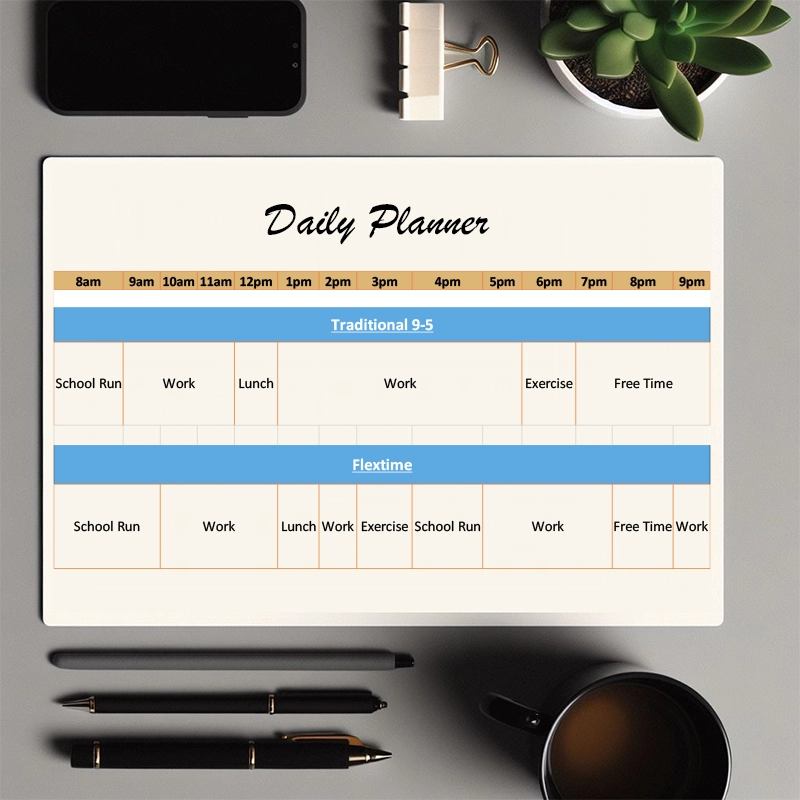
I’m a big believer in experimentation and flexibility when it comes to how we manage our work life relationship.
4 day work weeks, unlimited vacation time and flextime are all initiatives that deserve exploration.
In the modern workplace, the traditional nine-to-five schedule is becoming less common as organizations recognize the importance of work-life balance.
What Is Flextime?
Flextime is a work arrangement that allows you to have greater control over when you start and end your workday.
This flexibility can help you better manage personal commitments, reduce commute times, and enhance overall job satisfaction.
Flextime is not just about choosing your hours. It’s about finding a rhythm that aligns with business needs and personal preferences, creating a more dynamic and responsive structure to your day.
When implemented well, flextime can benefit both employers and employees, leading to increased productivity and engagement.
Key Takeaways
Understanding Flextime
Post Covid, the workforce has taken back some degree of control of their lives as our behaviours and needs have driven us toward a more equitable work-life balance.
Defining Flexible Working Hours
Flextime as a work arrangement enables you to select your work hours within the bounds of company policy.
Unlike fixed schedules, this approach often includes core hours during which you need to be available.
It also allows for the remaining hours to be adjustable according to your personal preferences and responsibilities.
My Experience Of Flextime
We actually have a flextime arrangement in our contracts at my work, although it’s rarely fully utilized by anyone.
You have to be available from 10-3 for meetings. The rest of the hours you can work whenever you like.
I mainly see it used by parents to help with the school run. That’s not to say others don’t utilize it more often. It’s hard to know for each individual.
Here’s how a traditional 9-5 working day might look for someone vs a flextime day.

Comparing Flextime To Traditional Work Schedules
Traditional schedules typically dictate a set number of hours and days, such as a 9-to-5, Monday through Friday workweek.
In contrast, flextime provides you with more autonomy and can include variations such as staggered hours, compressed workweeks, or remote work options.
Benefits And Challenges Of Flextime
Not every modern approach to work is perfect, there are some pros and cons to flextime that need to be considered.
Advantages For Employees And Employers
For both employees and employers, flextime provides notable benefits.
As an employee, you enjoy a greater sense of control over your work hours and improved autonomy.
From an employer’s perspective, offering flextime can be a great tool for attracting talent, reducing absenteeism, and enhancing employee commitment.
Top 3 benefits of flextime:
- Better Work-Life Balance
- Attracting the best talent/employee retention
- Higher productivity amongst staff
Disadvantages For Employees And Employers
On the flipside, flextime might lead to communication problems, especially when unexpected work or a crisis emerges at work.
If this happens between 3-5 for example when an employer is utilizing flextime, but needed to help the team, there could be a problem.
It can also blur the boundaries between work and life, which for some can make it hard to remain focused on one or the other.
Top 3 challenges of flextime:
- Communication difficulties
- Possible lack of career progression
- Blurred work-life boundaries
Navigating Operational Needs And Personal Lives
Striking a balance between operational needs and employees’ personal lives is an intricate setup.
Employers must ensure adequate staffing during peak periods and manage workflows effectively.
Employees, on their end, must navigate their personal responsibilities with the expectations of their roles.
Adapting to a flextime schedule requires clear communication and a degree of flexibility on both sides.
Addressing Common Flextime Misconceptions
There are also several misconceptions about flextime.
It’s commonly thought that flextime can lead to reduced productivity; however, studies often show the opposite to be true—when you’re able to work during your most productive hours, efficiency can improve.
According to The Balance, concerns about communication and cohesion in teams can often be mitigated through technology and good management practices.
Optimizing Flextime For Success
A strategic approach to flextime can boost your employee engagement, streamline evaluation processes, and help keep your policies fresh and effective through continuous revisions.
Strategies to Enhance Employee Engagement
Implementing flextime in a way that enhances employee engagement is crucial for success.
You can:
By strategically offering professional development during less busy times, you’ll ensure that flextime doesn’t hinder career growth.
Measuring And Evaluating Flextime Outcomes
Measuring performance can determine flextime’s effectiveness:
A clear evaluation process helps in identifying areas where flextime could be contributing to success and where it’s falling short.
Continuous Improvement And Flextime Revisions
Flextime isn’t a set-it-and-forget-it deal. It requires ongoing revision:
Employers Implementing Flextime
Clear policies, technologies to support flexible scheduling, and a straightforward process for requests and approvals are essential to help ensure a smooth implementation.
Creating Effective Flextime Policies
Firstly, you’ll want to develop flextime policies that are comprehensive yet flexible.
Your policy should clearly stipulate the core hours during which everyone needs to be available and specify any limits on scheduling.
Remember, your employee handbook is a great place to outline these guidelines.
Here’s an example of what the policy section in your handbook might look include stipulations like – Core hours requirement: 10 am – 3 pm or no start times before 7 am or after 10 am and no end times after 7 pm.
By doing so, you’re setting expectations that can lead to a respectful and productive work environment.
Technology’s Role In Supporting Flextime
Use scheduling software that allows employees to log their hours and managers to monitor adherence to the flextime policy.
For example, a software that enables you to view when your team members start and finish their day can provide transparency and trust in the system.
With the right tools, you can ensure that everyone stays on the same page without micromanagement.
Handling Requests And Approvals
Set up a system where employees can easily request changes to their schedules and managers can approve them in a timely manner.
Make sure to include a section in your flextime policy outlining how to handle these requests. For instance:
- Submit your flextime request via the company portal at least 48 hours in advance.
- Requests will be reviewed and responded to within 24 hours.
By having a clear process, you can minimize confusion and ensure fairness in how requests are handled.
Frequently Asked Questions

James Waite
Founder of Remoteopia, James has worked in remote roles for 6 years. After a stint in recruitment, he now works as a director of website strategy in tech.




